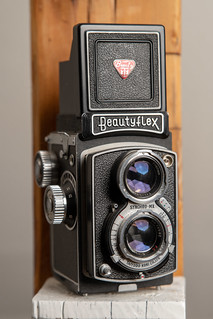Beautyflex
Beauty Flex and Beautyflex are a series of Japanese 6×6 TLR cameras and made by Taiyōdō Kōki.
Early Beauty Flex models have front lens cell focusing with a toothed-gear that couples the taking and viewing lenses, while later Beautyflex models have lens board movement focusing.
As was common practise among 1950s Japanese camera manufacturers, a number of the Beautyflex models where rebadged (made for other sellers with an altered identity) with modest specification changes, and rebranded (just given an alternative name for the manufacturer themselves to sell in different markets). The attribution of rebadges and rebrands can sometimes be tricky, but a good rule of thumb is - if the objective lens is not 80mm, Taiyōdō Kōki did not make it (however, there are two known exceptions - the original Beautyflex and the Japan only Beauty III).
Contents
Beauty Flex
Known through a January 1951 advertisement in Photo Art magazine [1] and rare surviving examples.
- Geared-lens focus
- Beauty 75mm f3.5 taking lens
- Unknown shutter with speeds of 1/15 to 1/150
- No accessory shoe or flash sync
Beauty Flex II
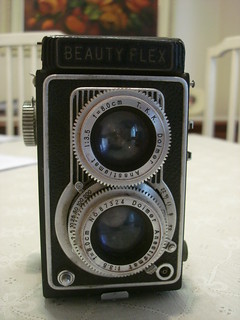
|
| Beautyflex V image by Claudio Costa (Image rights) |
- Thought to date to about 1951
- Doimer 80mm f3.5 taking lens
- TKK shutter with speeds of 1/10 to 1/200
- Accessory shoe
- Flash sync on front of body
- No logo on the viewfinder lid
- Name plate font outlined letters
Beauty Flex III
- Thought to date to about 1951
- As per II but with "T" logo on the viewfinder lid
- Modified back release catch
Beauty Flex IV (early & late versions)
- Thought to date to about 1951
- Name plate changed from flat plate to one with fluted edges and solid lettering
- Early version - resembles III, but the flash sync has been moved back to the side of the body.
- Late version - resembles a V (with a fluted decorative plate surrounding the lenses), but has the flash sync port on the lens
Beauty Flex V
- Thought to date to about 1953
- Closely resembles the later model IV with key differences
- 1. Rounded triangle TKK logo on the viewfinder lid
- 2. Etoal 1/10 to 1/200 shutter with front-mounted release
- 3. Synch plug socket bottom right
- 4. Modified catch for the back
- The Beautyflex V was rebranded as the (early) CSL Photoflex
Beautyflex S/Beauty S
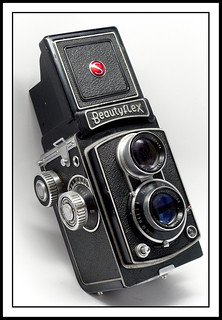
|
| Beautyflex S image by MC JC (Image rights) |
- This model introduced the transition from gear coupled taking and viewing lenses to lens board movement focusing
- Thought to date to about 1954.
- Lens: Beauty 80mm f3.5
- Shutter: NKS-FB MX 1 to 1/300
- Neither the S or the T featured the rounded triangle TKK logo on the viewfinder lid, as introduced in the V and carried forward to the D.
- There is a variant which has a "Beauty" name badge rather than "Beautyflex", and this was only sold in Japan.
Beauty III
- There was a further Japan only Beauty S variant called the "Beauty III", which had unusual 75mm f/3.1 lenses.
Beautyflex T
- Also thought to date to about 1954
- Looks similar to the S except that there is no decorative connecting block between the two lenses
- Lens: FC Telmer 80mm f3.5
- Shutter: TKK MX 1 to 1/300
- The Beautyflex T was rebadged as the Wardflex I, which was in turn rebranded by TKK as the Gen-flex (i.e. the Gen-flex is a copy of the Wardflex I rather than a copy of the Beautyflex T)
Beautyflex D
|
- Thought to date to about 1955
- Several Known Lens/Shutter combinations:
- 1. Biokor 3.5/80 mm lens in a Synchro-MX 1 - 1/300 shutter
- The Biokor/Synchro-MX variant was rebadged as the Wardflex II and the USC Auto Fifty, and also rebranded by TKK as the (late) CSL Photoflex
- 2. Biokor 3.5/80 mm lens in a Synchro-MXV 1 - 1/300 shutter
- The Biokor/Synchro-MXV variant was rebadged as the Fodorflex
- 3. Biokor 3.5/80 lens in a Rectus 1 - 1/300 shutter
- 4. Biokor 3.5/80 mm lens in a Copal-MX 1 - 300 shutter
Beautyflex 28
- Whilst commonly referred to as the 2.8, early Taiyōdō brochures identify the camera as the Beautyflex Model 28.
- This is an uncommon model, and among only a very few TLRs to have f/2.8 lenses (the best known being Rolleiflex models).
- There are three variants, which differ by their Rolleiflex compatible Bay filter fittings
- 1. No bayonet
- 2. Single Bay III mounting on the taking lens
- 3. Double Bay III mounting on both lenses
- All three variants share the same lenses and shutter
- Lens - Cantor 80mm f2.8
- Shutter - Copal 1 to 1/200
 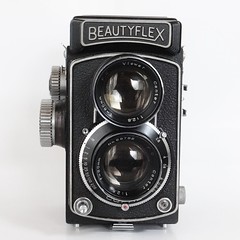 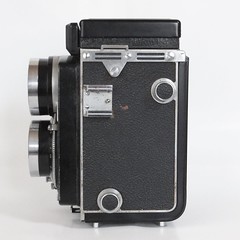
|
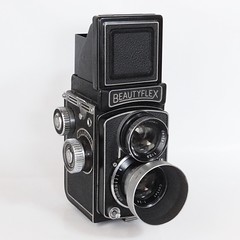 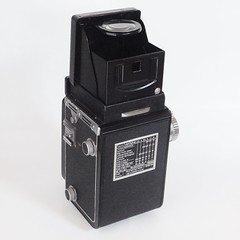 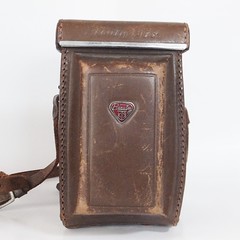
|
| Taiyōdō Kōki Beautyflex Model 28 without filter bayonets Images by yalluflex. (Image rights) |
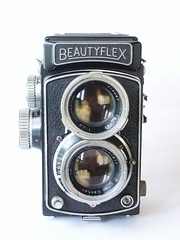 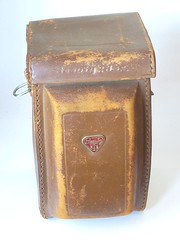 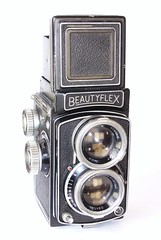
|
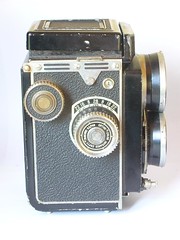 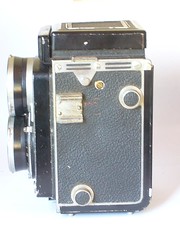 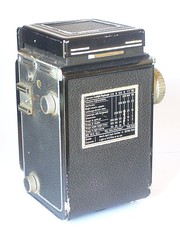
|
| Taiyōdō Kōki Beautyflex Model 28 with filter bayonets on both lenses Images by yalluflex. (Image rights) |
Bibliography
- Advertisement for the Beauty Flex II in the January 1951 issue of Photo Art (フォトアート) reproduced on Flickr (please see Note 1 below).
- Watakushi no ni-gan-refu kamera-ten (私の二眼レフカメラ展, Exhibition of twin lens reflex cameras). Tokyo: JCII Camera Museum, 1992. (Exhibition catalogue, no ISBN number.) P. 26.
Notes
- ↑ Do not assume that the symbol appearing immediately after the name is a Roman II: it is not. This group of symbols is not recognised as language by translators, nor as language characters by text extractors. Their meaning is unclear, but they appear in advertising and articles after the name of other early Beauty Flex models.
Links

|
| Comparison with a better-known Japanese TLR image by kavandje (Image rights) |
In Japanese:
- Taiyodo Koki TLRs at Dujingtou.com
- Beautyflex IV at Awane-Photo's camera museum
- Beautyflex V at Otowa no nigan-refu (archived)
- Beautyflex T at Awane-Photo's camera museum
- Beautyflex T at Otowa no nigan-refu (archived)
In English;
- Beautyflex on Westfordcomp.com
- Study on Taiyodo Koki TLR's on Barry Togoods TLR Cameras Website
- Beautyflex Models S and D plus Wardflex (Beautyflex Model T) instruction manuals in PDF format (English) from OrphanCameras.com website
- A link to an illustrated PDF guide to Beauty Flex/Beautyflex models can found at Taiyodo Koki & the Beauty Camera Company
